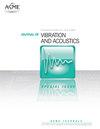Unique Loss Factor Images for Complex Dynamic Systems
IF 1.9
4区 工程技术
Q2 ACOUSTICS
Journal of Vibration and Acoustics-Transactions of the Asme
Pub Date : 2022-04-18
DOI:10.1115/1.4054360
引用次数: 0
Abstract
Over the past century, a number of scalar metrics have been proposed to measure the damping of a complex system. The present work explores these metrics in the context of finite element models. Perhaps the most common is the system loss factor, which is proportional to the ratio of energy dissipated over a cycle to the total energy of vibration. However, the total energy of vibration is difficult to define for a damped system because the total energy of vibration may vary considerably over the cycle. The present work addresses this ambiguity by uniquely defining the total energy of vibration as the sum of the kinetic and potential energies averaged over a cycle. Using the proposed definition, the system loss factor is analyzed for the cases of viscous and structural damping. For viscous damping, the system loss factor is found to be equal to twice the modal damping ratio when the system is excited at an undamped natural frequency and responds in the corresponding undamped mode shape. The energy dissipated over a cycle is expressed as a sum over finite elements so that the contribution of each finite element to the system loss factor is quantified. The visual representation of terms in the sum mapped to their spatial locations creates a loss factor image. Moreover, analysis provides an easily computed sensitivity of the loss factor with respect to the damping in one or more finite elements.复杂动态系统的独特损耗因子图像
在过去的一个世纪里,已经提出了一些标量度量来测量一个复杂系统的阻尼。目前的工作探讨这些指标在有限元模型的背景下。也许最常见的是系统损耗因子,它与在一个周期内耗散的能量与振动总能量的比率成正比。然而,由于振动的总能量在整个循环过程中变化很大,因此很难确定阻尼系统的振动总能量。目前的工作通过独特地定义振动的总能量为在一个周期内平均的动能和势能的总和来解决这种模糊性。利用提出的定义,分析了粘性阻尼和结构阻尼情况下的系统损耗因子。对于粘性阻尼,当系统以无阻尼固有频率激励并以相应的无阻尼振型响应时,系统损失因子等于模态阻尼比的两倍。在一个循环中耗散的能量被表示为有限单元的总和,这样每个有限单元对系统损耗因子的贡献就被量化了。将求和中的项的视觉表示映射到它们的空间位置,创建一个损失因子图像。此外,分析提供了一个容易计算的灵敏度损失因子相对于阻尼在一个或多个有限元。
本文章由计算机程序翻译,如有差异,请以英文原文为准。
求助全文
约1分钟内获得全文
求助全文
来源期刊
CiteScore
4.20
自引率
11.80%
发文量
79
审稿时长
7 months
期刊介绍:
The Journal of Vibration and Acoustics is sponsored jointly by the Design Engineering and the Noise Control and Acoustics Divisions of ASME. The Journal is the premier international venue for publication of original research concerning mechanical vibration and sound. Our mission is to serve researchers and practitioners who seek cutting-edge theories and computational and experimental methods that advance these fields. Our published studies reveal how mechanical vibration and sound impact the design and performance of engineered devices and structures and how to control their negative influences.
Vibration of continuous and discrete dynamical systems; Linear and nonlinear vibrations; Random vibrations; Wave propagation; Modal analysis; Mechanical signature analysis; Structural dynamics and control; Vibration energy harvesting; Vibration suppression; Vibration isolation; Passive and active damping; Machinery dynamics; Rotor dynamics; Acoustic emission; Noise control; Machinery noise; Structural acoustics; Fluid-structure interaction; Aeroelasticity; Flow-induced vibration and noise.

 求助内容:
求助内容: 应助结果提醒方式:
应助结果提醒方式:


